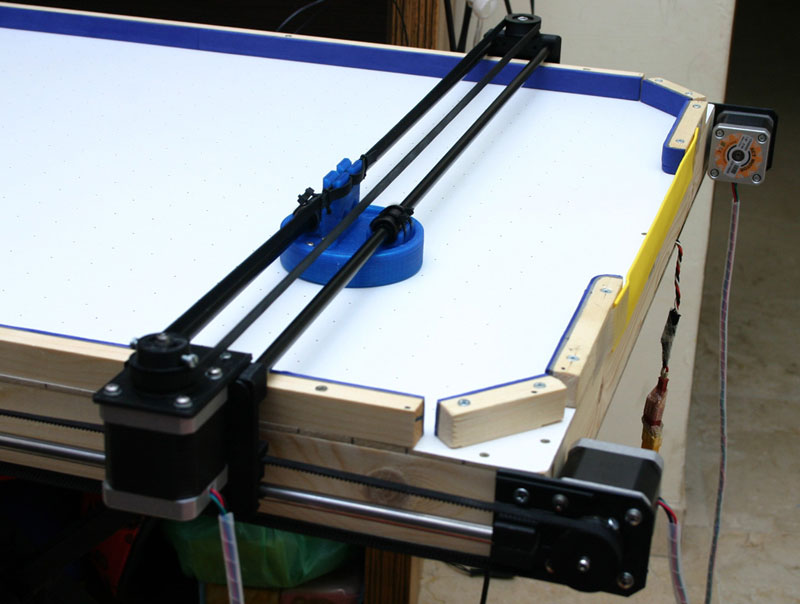We’ve all been disappointed at some point in our lives after yearning to play air hockey and not finding anyone to play against. This is no longer a problem at [Jose]’s house. He has built a very amazing Air Hockey Playing Robot. This robot moves in 2 directions, can predict the movements of the puck and also decide to block, shoot or a do a combination of both.
Surprisingly, most of the ‘robotics’ parts are 3D printer left overs, which includes: NEMA17 stepper motors, an Arduino Mega, a RAMPS board, motor drivers, belts, bearings and rods. The bracketry, puck and paddle are all 3D printed. The air hockey table itself was built from scratch using off-the-shelf wood. Two standard 90mm PC fans are all that are responsible for creating the air pressure used to lift the puck. A PS3 camera monitors the action and is literally this robot’s eye in the sky.
Check out the video and learn more about this project after the break.
Perhaps the most impressive part of this build is the way that it works. The camera mounted above the table watches the puck and determines its trajectory. The the robot then moves the paddle to the appropriate position to block and return the puck. The trajectory prediction can even take into account bounces off the wall. In case you are a sore loser, it is easy to adjust the robot’s speed, acceleration and strategy algorithms in order to guarantee yourself a win.

This is a complicated build and [Jose] did indeed have some problems to solve along the way. Originally, the rails that spanned the table were made of steel and turned out to be too heavy for the performance characteristics required of the gantry. The steel rods were replaced with carbon fiber tubes intended for kites. The lower weight reduced the gantry’s inertia and allowed for faster movements with less effort from the motors.
If you would like to try your hand at building one of these robots, [Jose] has written an extremely detailed manual and makes all of the software and firmware files available on his site. If only he had developed this just a year ago, we are sure he would have taken home the cup at this tournament.















HOT DAMN. That really is cool.
I’d imagine that that would be a pretty cool thing to have in an arcade, if those still exist.
Would it be possible to have different difficulty settings?
If I had some 3D printer leftovers, I’d build a…. 3D printer. But this looks like smashing fun. Wonder if you could integrate a moving magnet or a column of air under the table and remove the upper carriages for a neater look?
Reminds me of the air hockey robot at the Questacon science museum. It’s very very hard to beat (I’ve never managed to score against it, nor seen anyone else do it).
http://www.questacon.edu.au/visiting/galleries/excite-at-q/exhibits/robot-hockey
Uses an industrial robot to do it (so one end of the table is enclosed in a protective acrylic cage).
http://www.youtube.com/watch?v=MLBBL-Zsi0I
(it has an air blower on the paddle it uses if the puck is stuck out of it’s reach)
Beat me to it! I was about to post about this :) I managed to score one point against it when I was there a few weeks ago. Loads of fun. They have a display screen around the side that reads out all the parameters from the control system.
Build a second robot on the other end of the table!
+1, oh, and Mr. Robogretzky, no, I will not eat you! (Watch the video.)
That would be very interesting to see!
“Number of players – zero.”
My only take-away from the video is how much that chick CHEATS.
Cut her some slack, she’s just a little kid.
Damn! What’s most impressive has got to be the algorithms behind that. That’s very well done.
This is by far the best project I have seen so far.
THE BEST
Quick! Someone regift me the steppers, shield, and an arduino mega and I’ll put together the best magnetic self playing table you have ever seen! After I build a cnc to make it of course…
Eh Bien
+1 realy nice project!
Where’s the arduino haters now? This project has lots of things going for it, mechanical, controls, motors, sensors, and algorithms. All around very cool. And if you think about it, just 2 parallel rubber belts down the sides of the table and then one across and you have basically all the movement you need for air hockey; no 3D movement.
The PC is doing the heavy lifting here. You could just as well control the stepper drives from the parallel port.
Ooh, this is nice! Wish I had the skill to do this…
The only way to gain skill is by making lots and lots of mistakes. The learning curve for hardware is weird because it involves financial penalties, electrocution, long delays between development cycles and being forced to adopt peculiar debugging tools. Many learn to cut corners by salvaging stuff, adopting safety standards, keeping notes, taking long walks before submitting the PCB order and developing your own tools. That’s where the skill lies: a wild collection of anecdotes, mental notes and minor traumas.
So skill in development of hardware is dominated by evolutionary pressure. Survival of the luckiest/deepest pockets?
Makes sense as most of the notable projects on here certainly do not come from anyone that is less than upper middle class with a significant college fund and family support.
The Matthew principle strikes again. Hacking that should win a noble prize or three (clearly peace, economics, and physics).
That’s not what I stated.
STOP SAYING AFTER THE BREAK
The terminator of air hockey. I need this robot because my friends are no fun and never want to play air hockey. The robot will never let me down!